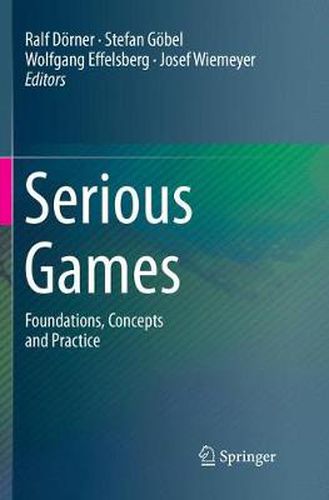Readings Newsletter
Become a Readings Member to make your shopping experience even easier.
Sign in or sign up for free!
You’re not far away from qualifying for FREE standard shipping within Australia
You’ve qualified for FREE standard shipping within Australia
The cart is loading…






This title is printed to order. This book may have been self-published. If so, we cannot guarantee the quality of the content. In the main most books will have gone through the editing process however some may not. We therefore suggest that you be aware of this before ordering this book. If in doubt check either the author or publisher’s details as we are unable to accept any returns unless they are faulty. Please contact us if you have any questions.
This textbook provides an introduction to the fundamentals of serious games, which differ considerably from computer games that are meant for pure entertainment.
Undergraduate and graduate students from various disciplines who want to learn about serious games are one target group of this book. Prospective developers of serious games are another, as they can use the book for self-study in order to learn about the distinctive features of serious game design and development. And ultimately, the book also addresses prospective users of serious game technologies by providing them with a solid basis for judging the advantages and limitations of serious games in different application areas such as game-based learning, training and simulation or games for health.
To cater to this heterogeneous readership and wide range of interests, every effort was made to make the book flexible to use. All readers are expected to study Chapter 1, as it provides the necessary basics and terminology that will be used in all subsequent chapters. The eleven chapters that follow cover the creation of serious games (design, authoring processes and tools, content production), the runtime context of serious games (game engines, adaptation mechanisms, game balancing, game mastering, multi-player serious games), the effects of serious games and their evaluation (player experience, assessment techniques, performance indicators), and serious games in practice (economic aspects, cost-benefit analysis, serious game distribution). To familiarize the readers with best practice in this field, the final chapter presents more than 30 selected examples of serious games illustrating their characteristics and showcasing their practical use.
Lecturers can select chapters in a sequence that is most suitable for their specific course or seminar. The book includes specific suggestions for courses such as Introduction to Serious Games , Entertainment Technology , Serious Game Design , Game-based Learning , and Applications of Serious Games .
$9.00 standard shipping within Australia
FREE standard shipping within Australia for orders over $100.00
Express & International shipping calculated at checkout
This title is printed to order. This book may have been self-published. If so, we cannot guarantee the quality of the content. In the main most books will have gone through the editing process however some may not. We therefore suggest that you be aware of this before ordering this book. If in doubt check either the author or publisher’s details as we are unable to accept any returns unless they are faulty. Please contact us if you have any questions.
This textbook provides an introduction to the fundamentals of serious games, which differ considerably from computer games that are meant for pure entertainment.
Undergraduate and graduate students from various disciplines who want to learn about serious games are one target group of this book. Prospective developers of serious games are another, as they can use the book for self-study in order to learn about the distinctive features of serious game design and development. And ultimately, the book also addresses prospective users of serious game technologies by providing them with a solid basis for judging the advantages and limitations of serious games in different application areas such as game-based learning, training and simulation or games for health.
To cater to this heterogeneous readership and wide range of interests, every effort was made to make the book flexible to use. All readers are expected to study Chapter 1, as it provides the necessary basics and terminology that will be used in all subsequent chapters. The eleven chapters that follow cover the creation of serious games (design, authoring processes and tools, content production), the runtime context of serious games (game engines, adaptation mechanisms, game balancing, game mastering, multi-player serious games), the effects of serious games and their evaluation (player experience, assessment techniques, performance indicators), and serious games in practice (economic aspects, cost-benefit analysis, serious game distribution). To familiarize the readers with best practice in this field, the final chapter presents more than 30 selected examples of serious games illustrating their characteristics and showcasing their practical use.
Lecturers can select chapters in a sequence that is most suitable for their specific course or seminar. The book includes specific suggestions for courses such as Introduction to Serious Games , Entertainment Technology , Serious Game Design , Game-based Learning , and Applications of Serious Games .